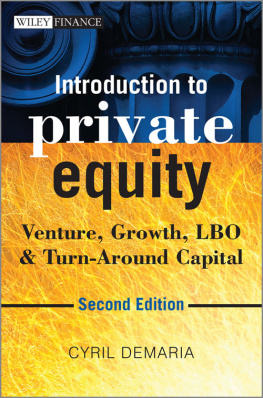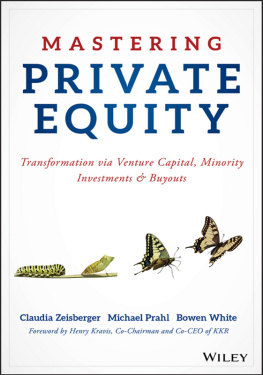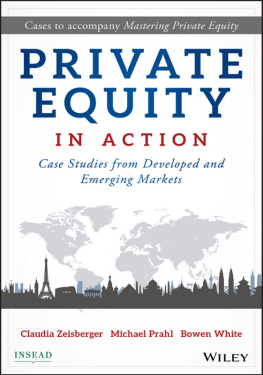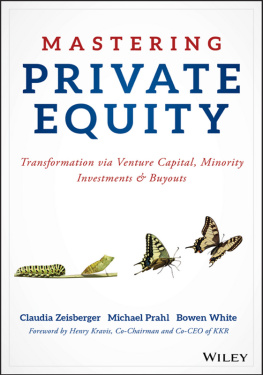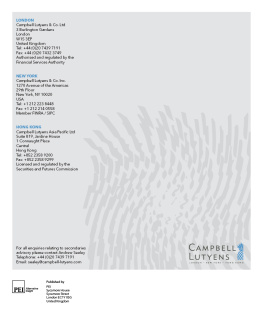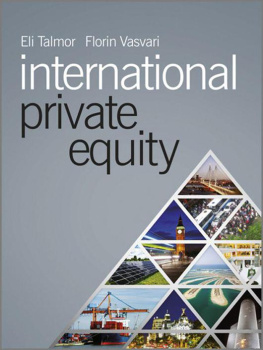Private Equity
Mathematics
An essential guide to investing in private equity, acquiring portfolio companies and running a private equity firm
Edited by Professor Oliver Gottschalg
 | London | New York | Singapore | www.peimedia.com |
Published in March 2009 by
PEI Media Ltd
Second Floor
Sycamore House
Sycamore Street
London EC1Y 0SG
United Kingdom
Telephone: +44 (0)20 7566 5444
www.peimedia.com
2009 PEI Media Ltd.
ISBN 978-1-904-696-60-5
eISBN 978-1-908-783-50-9
This publication is not included in the CLA Licence so you must not copy any portion of it without the permission of the publisher.
All rights reserved. No parts of this publication may be reproduced, stored in a retrieval system or transmitted in any form or by any means including electronic, mechanical, photocopy, recording or otherwise, without written permission of the publisher.
The views and opinions expressed in the book are solely those of the authors and need not reflect those of their employing institutions.
Although every reasonable effort has been made to ensure the accuracy of this publication, the publisher accepts no responsibility for any errors or omissions within this publication or for any expense or other loss alleged to have arisen in any way in connection with a readers use of this publication.
About the author
Professor Oliver Gottschalg is part of the Strategy Department at HEC School of Management, Paris. He serves as director of the Entrepreneurship Track in the HEC MBA programme, directs the HEC Buyout Research Group and teaches courses on strategy, entrepreneurship, business plan design and management buyouts. He holds a Wirtschaftsingenieur Diploma from the University of Karlsruhe, an MBA from Georgia State University and an MSc and PhD degree from INSEAD. His current research focuses on the strategic logic and the performance determinants of private equity investments. His work has been published in leading academic journals and in various publications for practitioners and was widely featured in the business press. He regularly presents his research at academic conferences and private equity symposia and serves as an advisor to leading investors in the private equity industry. He is founder and head of research at Peracs Ltd., a specialised advisory firm providing advanced private equity fund due diligence and benchmarking services. Most recently, he served as an advisor to the European Parliament in the context of the current debate about a possible need for regulation of the private equity industry.
Figures and tables
Figures
Tables
Introduction
By Professor Oliver Gottschalg
Institutional private equity is a relatively young investment category according to most standards. It was less than four decades ago that the industrys pioneers, such as Henry Kravis, Martin Dubilier or Joseph Rice, created an investment model and form of governance that gained prominence to that point that the asset class has attained the lofty moniker of Capitalisms New King. Private equity has grown, matured, expanded its global reach and has attracted some outstanding human talent. At the same time, institutional private equity has become an industry in its own right with an increasing level of professionalisation.
While many would agree that investing in private equity is still much of an art when compared to other asset classes, the private equity industry has by now developed a wide range of specific and dedicated tools, benchmarks and methods that help investors (both at the general partner (GP) and at the limited partner (LP) level) to make the right investment decisions. Being a great artist requires the mastery of tools and methods. And without a doubt, the professionalisation of the private equity industry has raised the bar for investors with respect to this requirement.
Still, it is striking that the accessibility of knowledge about this asset class remains low when compared to its economic relevance. At its last peak during the first half of 2007, private equity was responsible for close to 50 percent of the worlds acquisitions, yet a search in the electronic databases of business journals reveals that there are over ten times more articles written on mergers and acquisitions than on private equity.
For years, many people believed that almost any form of private equity investment was a sure path to outstanding performance. While research shows that this belief has never been warranted, the current economic difficulties emphasise once again that only skilled investors can expect to reap attractive returns. Private equity remains a relatively opaque asset class with great information asymmetries. This implies substantial opportunities for investors with superior skills and capabilities often at the expense of the less skilled.
Historically, the spread between the best and the worst investment opportunities has been much greater in private equity than in many other asset classes. Being average has never been much fun in private equity and only the upper half of the performance spectrum yielded returns that compensated investors for the risk and the illiquidity of this type of investment. At the same time, the very best private equity investments generated an almost unparalleled performance. It is more than likely that in the current economic situation, in which returns are under pressure across asset classes, the difference between the best and worst private equity investments will further increase.
This emphasises the need for investors to be equipped with the latest and most sophisticated methods and techniques when it come to the assessment of investment opportunities, to the valuation of businesses, to the benchmarking of portfolio performance and to the design of incentives for executives and fund managers.
It is the objective of this book to provide a comprehensive and timely account of the state-of-the-art, available mathematical tools and methods that inform and guide relevant decisions in all aspects of private equity investing. It presents theoretical background and lays out formulae whenever necessary. At the same time it has been written in a pragmatic spirit and intends to focus on the question How to ? rather than on the latest abstract theoretical debate around a given concept. As such, most chapters include practical example calculations that can be easily adjusted to the real-world applications in the ).
On behalf of all of the readers of this book I would like to extend my thanks the 20 chapter contributors for sharing insights on their respective area of expertise with us. Their investment of time and their willingness to make best practices available is greatly appreciated, as without it, this book project would never have been possible. It is my hope that private equity professionals will be able to improve their investment decisions based on the mathematical methods and tools contained within this publication and that it further contributes to the advancement of knowledge about this important and expanding asset class.
Chapter overview
Quantitative tools and methods provide decision support for private equity investors in a variety of situations. This book is broadly separated into three sections. The first section, entitled Investing in private equity, looks at private equity as an asset class and takes to some extent the perspective of LPs seeking to evaluate, assess and benchmark private equity investment opportunities. The second section, called
Next page

